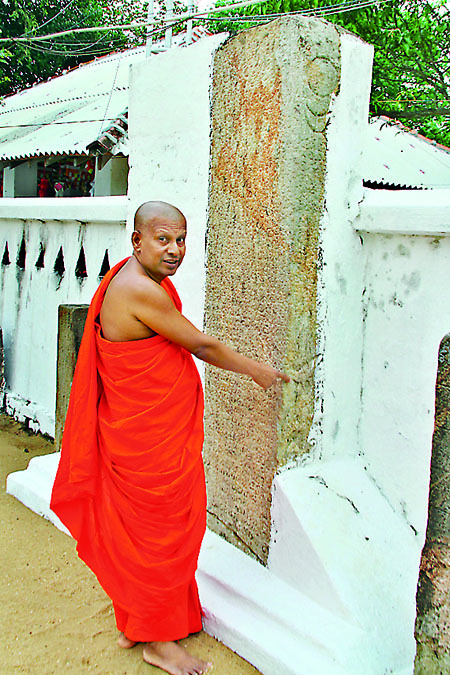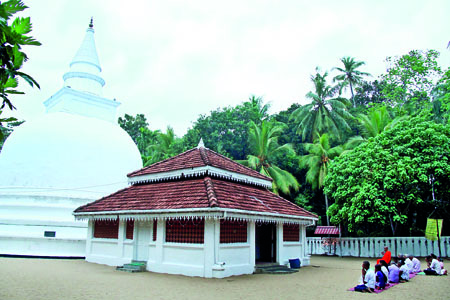A sacred ground in the shadow of the Kelaniya temple

Viharidhkari, Ven. Unana Upananda Thera besides the stone tablet at Kithsirimevan Raja Maha Viharaya. Pix by Indika Handuwala
On the invitation of the Naga King Maniakkhika, Lord Buddha in the eighth year after his Enlightenment, visited Kelaniya with his followers on a Vesak poya day, chronicle the Mahavamsa and Dipavamsa. It is common knowledge to Lankan Buddhists that the king built Kelaniya Raja MahaViharaya enshrining thejewelled throne on which Lord Buddha is said to have been seated while preaching Dhamma to the King and his followers.
The history of this hallowed place of worship for Buddhists dates back to pre- 500 BCE as the sacred ground visited by Buddha on his third visit to the island, having visited Mahiyanganaya and Nagadeepa previously. Intertwined in this famed legend of Kelani Raja MahaViharaya is the lesser known saga of Kithsirimewan Raja Maha Viharaya or Megoda Pansala in the vicinity of the former.
The rustling of bo and naa leaves in the evening breeze is the only hum which envelopes the few devotees on a weekday at Kithsirimewan Raja MahaViharaya. Come Poya, devotees throng the viharaya. So much so, it takes nearly two hours of waiting at times for the devotees to pay homage to the siripathula (sacred footprint of Lord Buddha) marked in the sacred compound says the Viharadhikari, Venerable Unana Upananda Thera. âIt is only after the construction of the bridge along the old Kandy road that public access to the temple became easier, especially with the Kelani river overflowing several times a year,â reflects UpanandaThera who could recollect a footpath from the main road accessing the temple when he first arrived ten years ago. âVillagers used to call the surrounding thickets wawulkele,â he adds.
Shedding light on the historical significance of the temple which comes under the guardianship of Kelani Raja Maha Vihara, the prelate says: âHaving preached Dhamma to King Maniakkhika and partaken alms, Lord Buddha had bathed in the Kelani river before leaving for Siripada with his followers. The bathing robe (jalasaatikawa) he was clad in, is enshrined in the stupa of this temple, which is known as sivurudageba. It is also believed that 500 rahathun accompanied Lord Buddha and the stupa is the repository of their begging bowls or paaththara as well.â The stupa which is said to have been originally built by the Naga King Maniakkhika had been restored and rendered royal patronage from time to time by several monarchs and most notably by King Kithsirimewan or Kirthi Sri Meghawanna, the son of King Mahasen, after whom the temple is known. A special gaatha paying homage to the temple further speaks for the reverence it attracts.
 Generations of villagers who have been associating Kithsirimewan Raja MahaViharaya believe in the miraculous powers of this revered place as a sacred ground touched by the grace of Lord Buddha. Vows or baara are made at the siripathula for recovery from ailments and many a trial and tribulation in their lives. Neela Silva is one such devotee who comes to the temple after work whenever time permits to help ease her mind from financial constraints she faces after her husbandâs untimely death. âIâm in serious debt and I come here very often to receive blessings to help me face adversity,â teary eyed Neela says. Kamani Alwis and her forefathersâ lives are closely intertwined with both Kithsirimewan Raja MahaViharaya and Kelani Raja MahaViharaya. âWe have been patronising the temples for generations both as donors and devotees,â she says.
Generations of villagers who have been associating Kithsirimewan Raja MahaViharaya believe in the miraculous powers of this revered place as a sacred ground touched by the grace of Lord Buddha. Vows or baara are made at the siripathula for recovery from ailments and many a trial and tribulation in their lives. Neela Silva is one such devotee who comes to the temple after work whenever time permits to help ease her mind from financial constraints she faces after her husbandâs untimely death. âIâm in serious debt and I come here very often to receive blessings to help me face adversity,â teary eyed Neela says. Kamani Alwis and her forefathersâ lives are closely intertwined with both Kithsirimewan Raja MahaViharaya and Kelani Raja MahaViharaya. âWe have been patronising the temples for generations both as donors and devotees,â she says.
Ruins of ancient stone sculptures and a stone tablet are also found in the temple grounds. The dates of these ruins are not yet determined according to the prelate of the Temple. When the ground was dug to lay some pipes, a sandakadapahana (moon stone) was also unearthed. However, no archaeological assessment of these items had yet been done. âA sannasa of Kotte era confirms that the temple had been restored by several monarchs, most notably by King Kithsirimewan and it further records that Kelaniya including the temple, had suffered serious damage during the Portuguese times in the Battle of Mulleriya,â explains Upananda Thera who also notes that according to the legend, King Buwanekabahu of Kotte used to visit the Kelaniya Temple on his tusker.
Interestingly Kithsirimewan Raja MahaViharaya had been an integral part of Kelani Raja MahaViharaya before a tsunami struck during King Kelanitissaâs time, as the Chief Incumbent of Kelaniya Raja Maha Viharaya, Professor Kollupitiye Mahinda Sangharakkhitha Thera points out. Ancient chronicles record the incident of Princess Devi (later Queen Vihara Maha Devi), daughter of King Kelanitissa being sacrificed to the tidal waves from Kelaniya as means of a ritual to spare the country of further catastrophe and how the boat carrying the princess was salvaged at Kirinda by King Kavantissa of Magama who made the brave princess his queen who became the mother of warrior king Dutugemunu.
âThis tsunami had altered the route of the Kelani river which inevitably separated Kelani Raja MahaViharaya and the premises where the present Kithsirimewan Raja MahaViharaya is found. Although geographically, it is so, Kithsirimewan Raja MahaViharaya still comes under the custodianship of the KelaniViharaya,â says the Chief Prelate. The sacred stupa of Kithsirimewan Raja MahaViharaya as it is found today, is credited to the latter part of the Kandyan Kingdom. âIt is believed that a Minister of King Keerthi Sri Rajasingheâs court renovated the stupa to its present glory.â The shrine room of Kithsirimewan Raja MahaViharaya is adorned with attractive murals which according to the Chief Prelate, dates back to the very early phases of the âColombo Eraâ.


